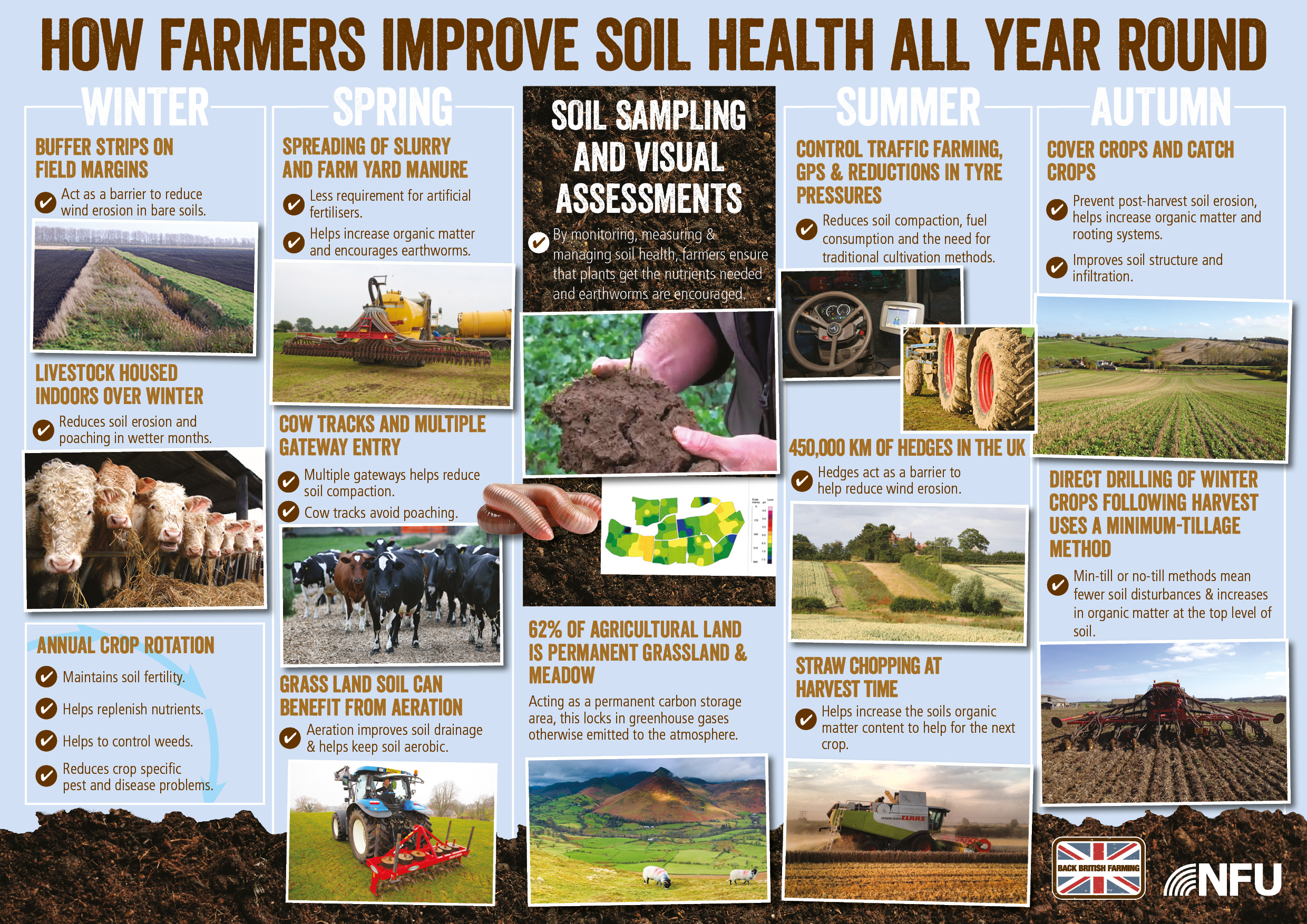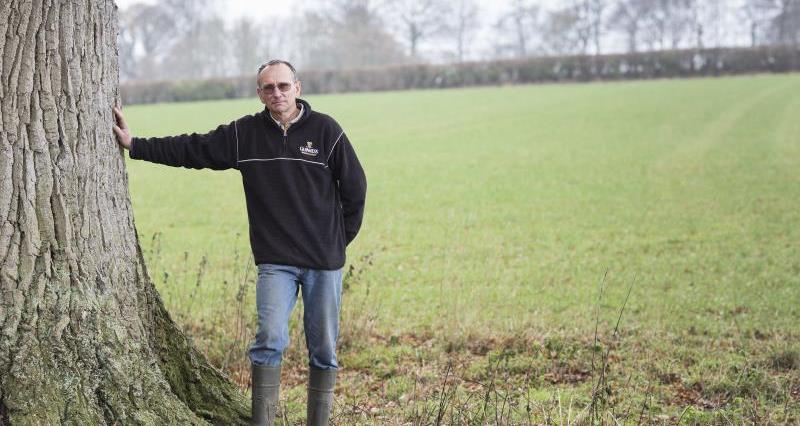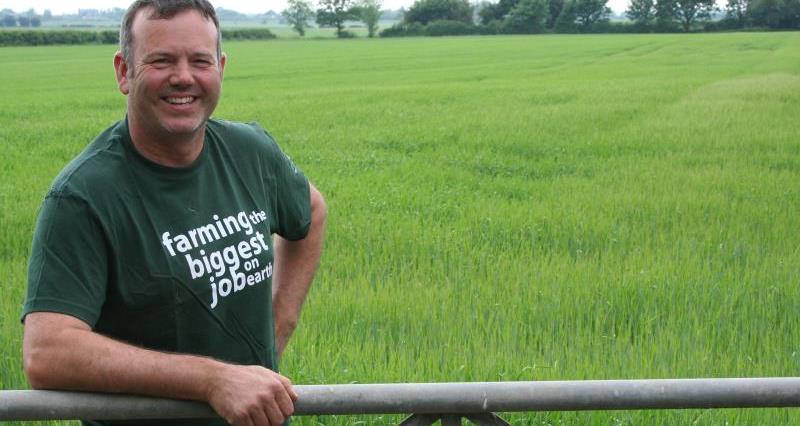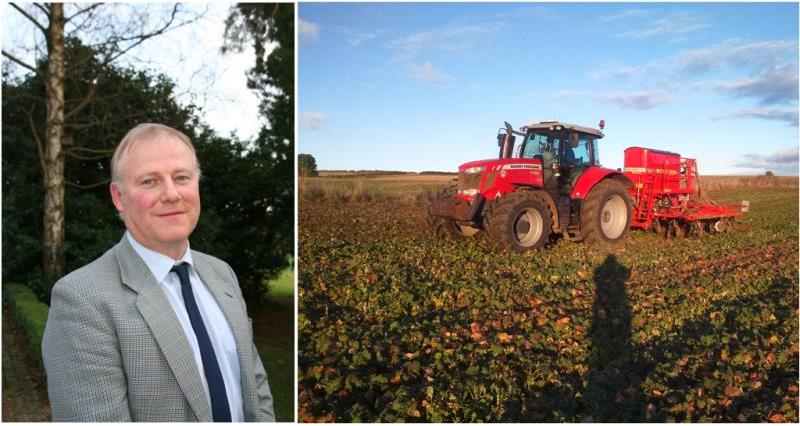Farmers manage 70% of Britain’s iconic countryside, and are dedicated to enhancing and protecting the environment, maintaining habitats for native plants and animals, maintaining footpaths, protecting watercourses and supporting wildlife species. Without fertile soils, farming is not productive. That’s why British farmers prioritise the protection and management of soil.
Frequently Asked Questions
Soil is a farmer’s greatest asset and is vital in producing healthy and bountiful crops to feed the nation. Not only this, but maintaining healthy soil is also key to building up resilience to events such as floods and droughts.
Soil biodiversity looks at the range of living organisms within the soil, including earthworms and plant roots which contribute towards the ecosystem living within the soil.
Soils hosts a quarter of our planet’s biodiversity. Soil is one of nature’s most complex ecosystems and one of the most diverse habitats on earth: it contains a myriad of different organisms, which interact and contribute to the global cycles that make all life possible.
Nowhere in nature are species so densely packed as in soil communities; however, this biodiversity is little known as it is underground and largely invisible to the human eye. A typical ecosystem in a healthy soil might contain several species of vertebrate animals, several species of earthworms, 20-30 species of mites, 50-100 species of insects, tens of species of nematodes, hundreds of species of fungi and perhaps thousands of species of bacteria and actinomycetes.
Over the last 30 years, farmers have almost halved the amount of chemical fertilisers and pesticides used (DEFRA), and increased the use of cover cropping and minimal tillage. Farmers recognise that good soil health is essential for productivity, sustainability and profitability. From housing livestock indoors in the winter, placing multiple gateways into one field and managing the way their winter crops are planted are all methods used by farmers to look after and improve soil health.
Farmers sample soil to monitor soil nutrients to ensure that plants get the nutrition they need and earthworms are encouraged.
Spreading of slurry and farm yard manure will increase the soils organic matter content and encourages earthworms which breakdown the waste and increase the soils fertility.
Throughout the year, farmers take various measures to help maintain and improve soil health.

1. Cover crops
Cover crops improve the organic matter levels in the soil, provide a crop canopy to stop erosion from the weather, recapture nutrient levels in the soil and generally add to the soil biodiversity by enhancing the water capture and nutrient content. Cover crops tend to be planted in the autumn to enhance soil biodiversity over the winter months, it is an effective way of weather proofing soil and protecting soil from erosion. Examples of cover crops include brassicas such as mustard, broadleaves such as radish, and those that are leguminous such as clover and vetch can fix nitrogen from the air, supplying nitrogen to the succeeding crop via the soil.
2. Reduce soil compaction
Control traffic farming (a system which consciously reduces the damage to soils caused by heavy or repeated agricultural machinery passes on the land) and reducing tyre pressures are measures that farmers take to maintain a healthy soil. Farmers also reduce the compaction of soil by housing livestock in barns over the winter months. In addition farmers try to ensure there are multiple gateway entries to fields to reduce soil compaction around gateways.
3. Crop rotation
Farmers use crop rotation as a method of maintaining soil fertility. The crop can be strategically grown to replenish nutrients that the previous crop may have reduced, which prevents nutrient exhaustion within the soil. Crop rotation also helps to control weeds and reduce crop specific pest and disease problems.
4. Soil management
By monitoring, measuring and managing soil, farmers ensure that soil health is optimised and their greatest asset is protected.
5. Preventing soil erosion
Soil erosion, a natural occurring process, is the wearing away of a field’s topsoil by the natural forces of water and wind. Farmers take precautions to prevent soil erosion where possible. Careful management of cover crops to protect bare soils over winter, buffer strips on field margins, hedges acting as barriers and less invasive cultivation methods to retain a good soil structure, the effect of the natural causes is limited. Maintaining organic matter levels will also reduce soil erosion. Some areas will be vulnerable to wind as well as water erosion and may not be suitable for cultivation, such as upland farms where permanent pasture for grazing are more suited.
Farmers do many things to protect, maintain and enhance the environment. Farmers are proud custodians of the countryside and work either voluntarily, through countryside stewardship schemes or adhere to agricultural cross compliance to reduce agricultures impact on the environment.
Farmers have planted 10,000 football pitches worth of flower habitat, creating homes for bees and food for birds and insects. Farmers reduce their yield by leaving field margins and corners for nature to thrive. 30,000km of hedgerows in England have been planted and cared for by farmers, providing food and shelter for wildlife.
Meet the farmers who play their part in improving soil health
Mark Pope farms 700 acres of arable land in Somerset, and has allowed coir rolls, which trap soil and water, to be placed in unproductive field corners to help prevent flooding.

Mark recognises that the environment is key to farming’s productive potential. Marks farm has 48 km of field margins, providing habitat and food for birds and insects, and all watercourses are protected with 6 m margins.
Countless field corners are left uncultivated, providing habitat for wildlife and encouraging diverse plant species types, and over the last 15 years Mark has laid and gapped up over 1000 m of hedgerow.
Following the Somerset floods in 2013/2014, Mark has participated in an initiative to put in place interventions to ‘slow the flow’ of water in the landscape. Mark has allowed coir rolls, which trap soil and water, to be placed in unproductive field corners.
Richard Bramley uses ‘cover cropping’ on his farm to preserve nutrients and protect soils at key times in the farming calendar.

Richard Bramley is an arable farmer from York, farming 500 acres of combinable and root crops. Alongside his arable operations, Richard is involved in a diverse range of environmental work on his farm.
All watercourses are protected with 7 m diverse margins, which include approximately 3 ha with flowering plants. In addition, he has 1 ha of land dedicated to providing overwintering bird food and 1 ha of pollen and nectar mix to provide food for bees, butterflies and other insects.
He has approximately 8 ha of grassland, which is mainly riverbanks and field corners, with no nutrient inputs, providing encouraging a diversity of plant species.
Roughly 12,000 of mixed hedgerow species types have been planted on Richard’s farm and 2,000 mixed trees.
Since 2007, Richard has used ‘cover cropping’ on the farm, which is temporary crop and is used to preserve nutrients and protect soils at key times in the farming calendar.
Solar power generated on the farm provides 100% of electricity for Richard’s farmhouse, office and three holiday barns. All heating is provided by biomass generated on the farm.
Phil Jarvis is working towards direct drilling on his farm, to allow the soils to remain undisturbed.

Phil Jarvis is the farm manager at the Allerton Project farm at Loddington in Leicestershire. The farm is 333 hectares growing winter wheat, winter oilseed rape, winter/spring oats and winter/spring beans. Sheep graze 30 hectares of permanent grassland. The farm has 20 hectares of woodland and numerous stream and ponds within its boundaries.
Soil management is important to farming operations at Loddington and Phil’s aim is to make the soils more resilient. Practices adopted on the farm include widening rotations, introducing cover crops, and making the transition towards direct drilling, which allows soils to remain undisturbed by leaving crop residues on the surface from harvest until sowing.
Water friendly farming measures have also being introduced. These include interceptor wetlands receiving water from surface runoff and field drains, streamside fencing and installation of alternative livestock drinking sites. There are many grass buffer strips already in place. Nutrient mapping and nutrient management planning have also been adopted.
All in all, some 10 % of the land at Loddington is out of production and in environmental enhancement to achieve benefits to water, pollinators, plants and other wildlife.